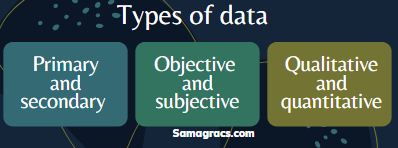Tools of data collection
Tools of data collection
In this tutorial, we will discuss tools of data collection in research.
| ✰ Data is defined as the information recorded to represent facts. Some important points about data are worth mentioning here, ⟹ Data represent facts about hypothesized variables. ⟹ Data is analyzed to determine consistency with prediction. Prediction is in the form of setting up of hypothesis. ⟹ If data and prediction are consistent, then null hypothesis is supported. ⟹ If data and prediction are inconsistent, hypothesis is not supported and is rejected. |
Types of data
Types of data
1. Primary and secondary.
2. Objective and subjective.
3. Qualitative and quantitative.

1. Primary and secondary:
1. Primary and secondary:
| Primary Data: ✰ Those which are collected afresh and for the first time, and thus happen to be original in character. ✰ It is based on surveys, observations, and experimentation. It is expensive and difficult to acquire. It is reliable as it has been obtained directly with a specific problem in view. Secondary Data: ✰ Primary data is collected for the purpose of the current research project, whereas secondary data is collected for some other research purpose. ✰ Those which have already been collected by someone else and which have already been passed through the statistical process. ✰ Secondary data is collected from external sources, such as TV, radio, the Internet, magazines, books and newspapers. ✰ It is an inexpensive and a quick method to obtain information. Sometimes, it is the only way when the original source is inaccessible. |
2. Objective and subjective.
2. Objective and Subjective:
| Objective: ✰ Objective data are independent of any single person’s opinion or the researcher. Subjective: ✰ Subjective data can be dependent upon an individual’s opinion or the researcher. |
3. Qualitative and quantitative.
3. Qualitative and Quantitative.
| Qualitative: ✰ Qualitative data is the description of things made without assigning numeric values. For example, facts generated from the unstructured interviews. It needs the researcher’s interpretation. Quantitative: ✰ Quantitative data entail measurements in which the numbers are used directly to represent the properties of things. It is ready for statistical analysis. A larger sample is required in quantitative data and with proper sampling design, the ability to generalize is also high. |
Also read important topic for UGC NET Paper 1
You Should Learn Sampling methods for Better Performance.
You should practice previous year solution on this topic. GO Below ☟
| Research Content : |
- Introduction of Research
- Objective of Research
- Desirable Motivation
- Characteristics of research
- Positivism or postpositivism
- Classification of research
- Fundamental research
- Applied research
- Difference between fundamental and applied research
- Quantitative research
- Qualitative research
- Descriptive research
- Correlational research
- Exploratory research
- Explanatory research
- Experimental Research
- True experimental VS Quasi-experimental
- Inductive Research
- Deductive Research
- Inductive Research VS Deductive Research
- Conceptual Research
- Empirical Research
- Conceptual Research VS Empirical Research
- Structured Research
- Unstructured Research
- Ex-post facto Research
- Historical Research
- Analytical research
- Steps of research
- Formulating the research problem
- Research variables
- measuring scales
- Attitudinal scale
- Hypothesis formulating
- S2-> Preparing the research design
- S3->Tools of data collection
- S4->Sampling methods
- S5->Research proposal
- collecting data
- Processing and Analysis Data
- measuring scales
- Sampling methods
- Research proposal
- collecting data
- Processing and Analysis Data
